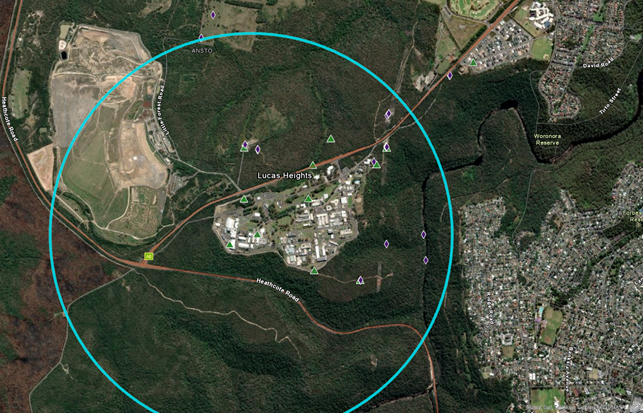ARPANSA scientists independently verified radiation levels at the Australian Nuclear Science and Technology Organisation's (ANSTO) Lucas Heights site between July 2023 and June 2024 as part of our role as independent regulator of Commonwealth agencies that use or produce radiation. ARPANSA’s verification program is in place to ensure the validity of measurements reported by ANSTO and ensure compliance with relevant licence conditions. Consistent results between ARPANSA and ANSTO laboratory measurements provide confidence in ANSTO’s monitoring capabilities and ensures ongoing protection of people and the environment.
We conduct quarterly and annual analyses of air filters, bore water, and ground water samples as part of our ongoing independent verification process. The comprehensive analyses confirmed that no samples exceeded site notification levels, indicating that ANSTO’s operations pose no undue risk to the environment or public health.
Figure 1 shows the locations of air and water samples validated by ARPANSA as part of this program.
 Figure 1: ANSTO site overview - The circle denotes the 1.6km buffer zone separating ANSTO from nearby residential areas. Triangles show the locations of baseline measurements taken in 2019. Diamonds indicate ongoing measurements.
Figure 1: ANSTO site overview - The circle denotes the 1.6km buffer zone separating ANSTO from nearby residential areas. Triangles show the locations of baseline measurements taken in 2019. Diamonds indicate ongoing measurements.
Verification samples
ANSTO uses carbon cartridge air filters to collect radioactive particles in the air as part of its environmental monitoring. Carbon cartridge air filters are collected in each quarter and measured by ANSTO and then passed to ARPANSA’s radioanalytical services (RAS) laboratory for verification of measurements. The comparison of measured activity in each sample is presented here and shows that all samples were well below the notification level. Notification levels are based on the conservative dose constraint of ANSTO’s license conditions, 0.3 mSv/year, which is below the public exposure limit of 1 mSv/year. As a result, no human health effects or impact to the environment are expected.
Stack discharge activity comparison
| Discharge stack | ANSTO I-131 activity (Bq) | ARPANSA I-131 activity (Bq) | % of notification level | Notification level exceeded? |
| B23A-1st Week 7 | 22.87 | 18 ± 2.4 | 0.0003 | No |
| B23A-2nd Week 7 | 11.67 | 12.6 ± 1.8 | 0.0002 | No |
| B23B Week 7 | 6.089 | 4.48 ± 0.70 | 0.029 | No |
| B27B Week 7 | 3201 | 2870 ± 350 | 3.34 | No |
| B88 RP-1st Week 16 | 3465 | 3220 ± 390 | 1.81 | No |
| B88 RP-2nd Week 16 | 1.023 | 0.61± 0.11 | 0.0005 | No |
| B88 RS Week 16 | 389.1 | 340 ± 41 | 0.2 | No |
| B88 BS Week 16 | 1.534 | 1.61 ±0.28 | 0.0005 | No |
| B23A-1st Week 31 | 15.97 | 13.5 ± 1.8 | 0.0002 | No |
| B23A-2nd Week 31 | 52.27 | 45.0± 5.6 | 0.0009 | No |
| B23B Week 31 | 4.944 | 4.50 ± 0.67 | 0.02 | No |
| B27B Week 31 | 1025 | 860 ± 100 | 1.1 | No |
Tritium concentration in groundwater bores
Water samples are collected twice a year by the ANSTO environmental monitoring team and since 2021 a subset of these samples have been sent to ARPANSA for analysis and comparison. The results from both ANSTO and ARPANSA are in good agreement and have been for all samples since 2021. All activity concentrations are well below the World Health Organisation (WHO) drinking water guideline limits for tritium at 10,000 Bq/L and below the gross alpha and beta (GAB) screening level of 0.5 Bq/L for drinking water.

Conclusion
ARPANSA’s independent measurements at ANSTO’s Lucas Heights site have consistently found levels of radiation in the environment to be low and in line with natural background radiation levels. Our measurements show good agreement with ANSTO measurements and demonstrate that ANSTO is fulfilling their duties as a licence holder to protect the people and the environment from the harmful effects of radiation.


